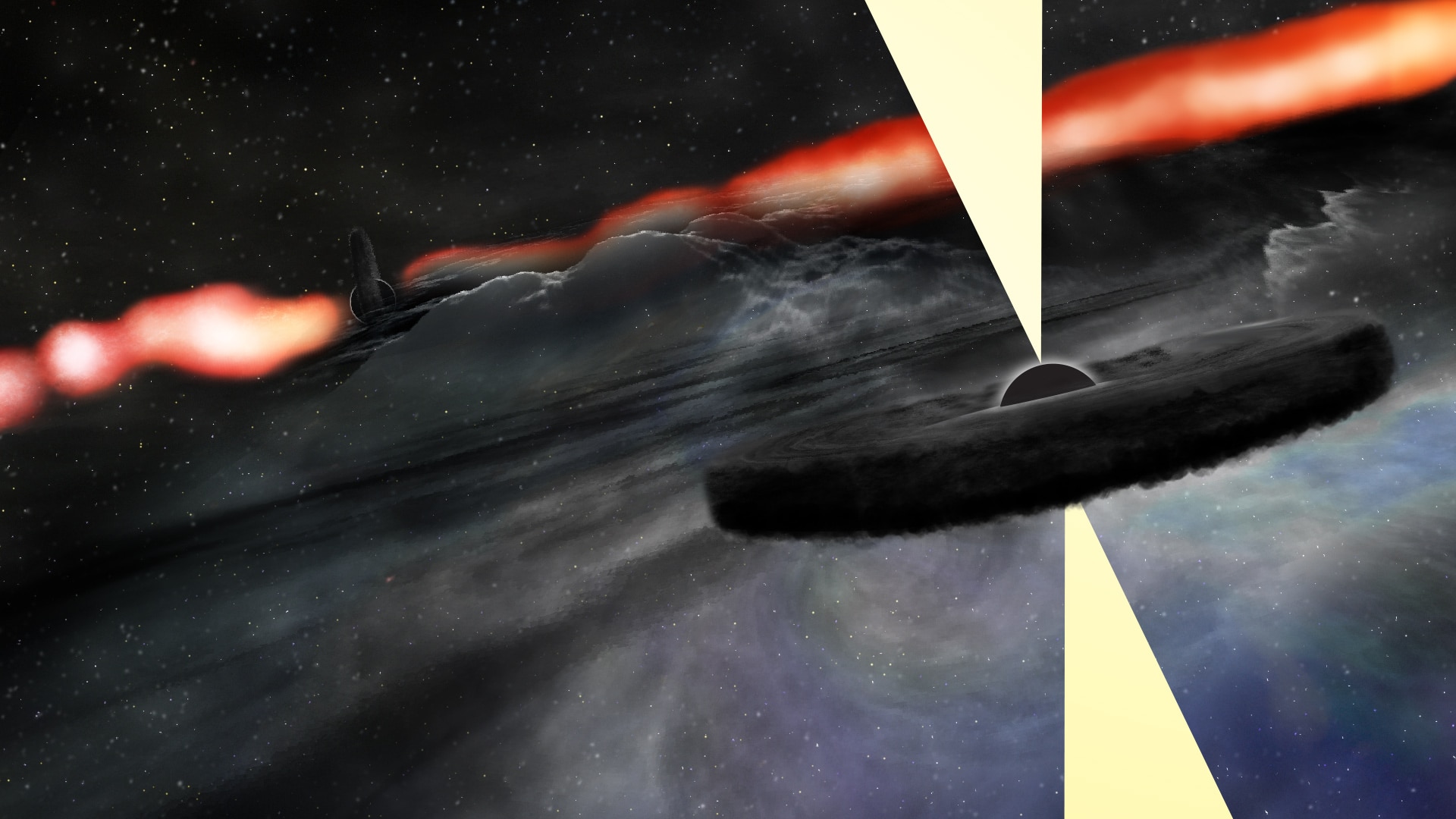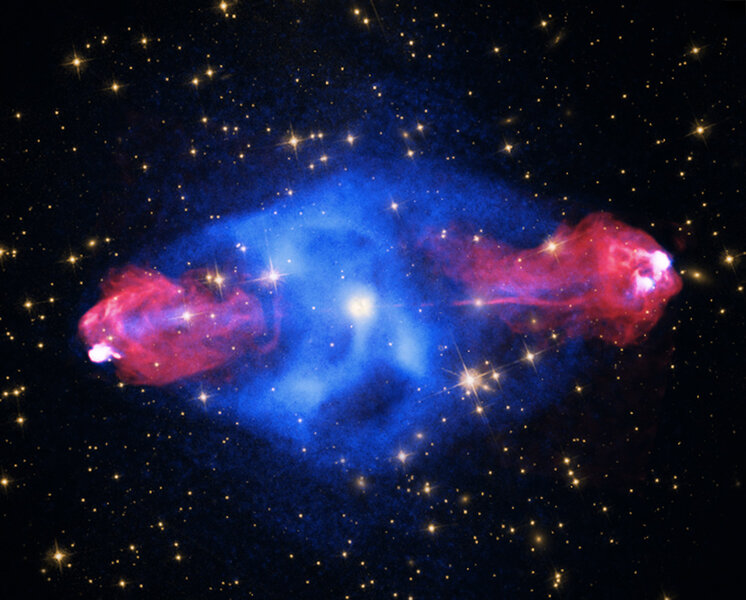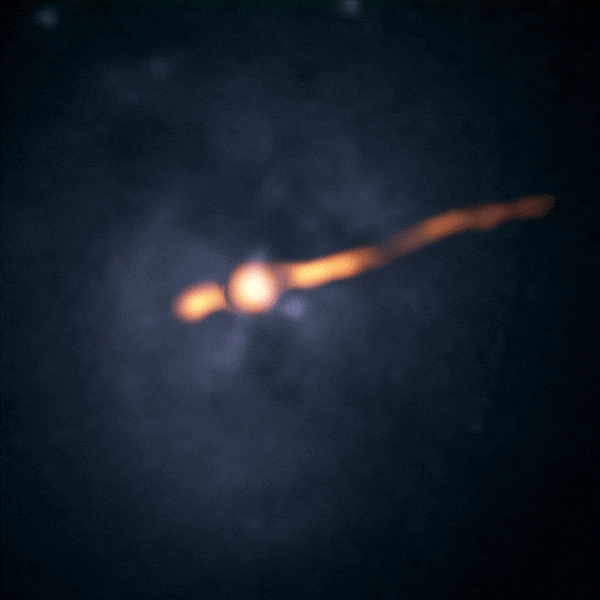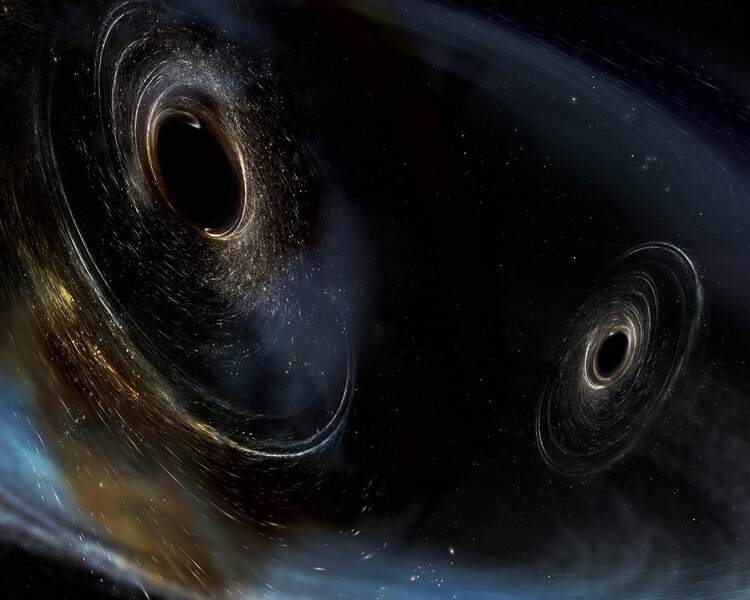Create a free profile to get unlimited access to exclusive videos, sweepstakes, and more!
A gigantic black hole finds its long-lost, and slightly less gigantic, sibling

750 million light-years away from Earth lies a thundering monster.
At the very center of an otherwise nondescript elliptical galaxy sits a black hole, and it’s a beast. It has a mass estimated to be a billion times that of the Sun, as massive as some entire smaller galaxies themselves.
Unlike the supermassive black hole at the center of our home galaxy, the Milky Way, this black hole is actively feeding, and like many other black holes in its size range it’s a sloppy eater. As material falls in, it forms a swirling disk outside the black hole called an accretion disk. The outer edges of the disk are orbiting at hundreds of kilometers per second, but the inner region moves at speeds a thousand times greater still, approaching the speed of light at the point of no return above the black hole.
The friction generated by this velocity gradient is enormous, terrifying. It heats the disk to millions of degrees and sets up fierce magnetic fields. All of this works together to power twin jets of matter and energy that scream away from the poles of the disk, blasting away so much energy that, despite its mind-crushing distance, this object is the second brightest radio source in our entire sky. Only the Sun is brighter.
We call this object Cygnus A, and it is the archetype “active galaxy,” tremendously luminous galaxies with powerful sources of energy in their core.
And now astronomers have discovered the black hole at the heart of this behemoth isn’t alone.
A lot of this black hole activity is best visible when observing radio waves (a lower-energy form of light than the kind we see), and astronomers have monitored it off and on for decades. But when observations were taken recently using the newly upgraded Very Large Array located in the desert near Socorro, New Mexico, they got a surprise: They found a second bright radio source located very close to the black hole, one that wasn’t there just a few years before.
Called Cygnus A-2, this is no dim bulb: It’s blasting out three million times the Sun’s energy, and that’s just in the radio part of the spectrum! If it weren’t sitting next to the core of Cygnus A (which is 100,000 times brighter) it would be considered a decent source all by itself.
But what is it? The energy emitted rules out lesser sources like stellar flares or novae. There are only two things powerful enough to fit the bill: a supernova, or another supermassive black hole.
A supernova is unlikely, though. The energy seen over time would put Cygnus A-2 at the top end of powerful supernovae, and they typically fade over the course of weeks, while this source has been steady. Also, a look into archival images of the core of Cygnus A taken by Hubble and the Keck telescopes shows a faint infrared source of energy there as long ago as 2002. That rules out a supernova.
That means what they’ve found is a second black hole. It’s not clear how massive it is, but it’s likely to be in the few-million-solar-mass range — far smaller than its big brother’s billion-solar-mass heft, but geez, still a whopper, roughly the same mass as the one in the center of the Milky Way. However, the observational data only weakly constrain the black hole mass calculation; it could be as low as a hundred thousand solar masses, or as high as a hundred million, too.
Where did it come from? It’s located a mere 1500 light-years or so away from the bigger black hole, and that’s really close on a galactic scale. It’s unlikely to have formed at the same time as big brother, too, or else it would’ve merged with it long, long ago.
That means it formed elsewhere. We think that every big galaxy has a black hole like this at its core, and moreover, we think that all big galaxies formed from mergers with other galaxies, growing in size as big ones cannibalize smaller ones. Putting that together, it means that Cygnus A-2 is what remains of what must have been a fairly decent-sized galaxy, but got eaten by the larger elliptical galaxy hosting Cygnus A. Over time, the smaller black hole would have fallen to the center in a process called dynamical friction; the black hole would lose velocity relative to the big galaxy as it flung around other objects like stars, causing it to slow and drop down toward the core.
Another question, more difficult to answer, is why it was dark when astronomers looked at Cygnus A before a decade or two ago, but suddenly became bright recently. That amount of energy means a lot of material must have been dumped into the black hole, forming an appreciable accretion disk. Maybe a third galaxy collided with the Cygnus A host galaxy, and the gravitational interaction dropped a lot of gas into the second black hole. That’s a common way for active galaxies to switch on. However, the increase of matter flowing into it would have to be pretty large to explain its brightness, putting it in the upper end of such events. Not impossible, but enough to trigger some skepticism.
There may be another explanation behind the sudden brightening of Cygnus A-2, but we’ll need a lot more observations to figure it out.
There’s another interesting thing about this. Given its distance from the other black hole, Cygnus A-2 should take about 10 million years to complete an orbit. This is also about the same amount of time the huge radio jets from Cygnus A have been active. That may be coincidence, but it may also mean that the second black hole somehow triggers the creation of the jets. It’s not at all clear how, but what is clear is that this is an amazing object that will be intensely scrutinized for a long time.
Maybe a very long time. Cygnus A-2 will almost certainly eventually merge with the bigger black hole. When it does, they will erupt with gravitational waves, blasting out so much energy it will dwarf their current emission, and in doing so will literally shake the fabric of space and time so much it will cause measurable distortions here on Earth. To be clear, I don’t mean it would wake you up out of bed, but special equipment would be able to detect it easily. That’ll be billions of years from now, which actually makes me rather sad; I’d love to see the data generated by such an event. Ah, well.
In the meantime, though, there’s plenty of work to do to understand this enigmatic object. As if black holes weren’t already odd enough.

















